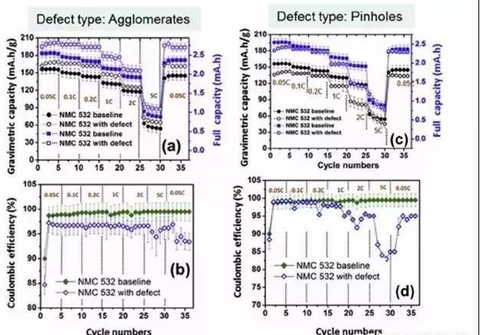
一般的な4sリポバッテリーのポールピース欠陥の種類とその影響および検出方法
以下の部分では、CNHL、リチウム4sリポバッテリーの製造元が、リチウム4sリポバッテリー表面欠陥の新しい検出技術である赤外線サーモグラフィ技術と、これらの異なる欠陥と電気化学性能との関係について簡単に紹介します。詳細な研究はD. Mohantyらによるものをご覧ください。
1 リチウム4sリポバッテリー極片表面の一般的な欠陥
図1はリチウム4sリポバッテリー極片表面の一般的な欠陥で、左は光学画像、右はサーモグラフィーで撮影した画像です。

図1 極片表面の一般的な欠陥:(a, b) 盛り上がった袋/凝集体;(c, d) 欠落/ピンホール;(e, f) 金属異物;(g, h) 不均一なコーティング
(a, b) 盛り上がった塊/凝集体、これらの欠陥はスラリーの攪拌が不均一であったり、コーティングの供給速度が不安定な場合に発生します。バインダーとカーボンブラック導電剤の凝集により、活性成分の含有量が低く、軽量の極片となります。
(c, d) 欠落/ピンホール、これらの欠陥部分はコーティングされておらず、通常はスラリー中の気泡によって作られます。これにより活性物質の量が減少し、集電体が電解質に露出して電気化学容量が低下します。
(e, f) 金属異物、スラリーや設備および環境に混入した金属異物は、リチウム4sリポバッテリーに非常に有害です。大きなサイズの金属粒子はセパレーターを直接突き刺し、正極と負極間の短絡を引き起こし、これは物理的な短絡です。さらに、金属異物が正極に混入すると、充電後に正極の電位が上昇し、金属が溶解して電解質を通じて拡散し、最終的に負極表面に沈着し、隔膜を突き破って短絡を形成します。これは化学的溶解短絡です。4sリポバッテリー工場現場で最も一般的な金属異物はFe、Cu、Zn、Al、Sn、SUSなどです。
(g, h) 不均一なコーティング、例えばスラリーの混合不足により、粒子の細かさが大きい場合に筋状の跡が現れやすくなり、不均一なコーティングとなります。これにより4sリポバッテリーの容量の一貫性に影響を与え、場合によっては全くコーティングがないように見える筋状の跡が現れ、容量と安全性の両方に影響を及ぼします。
2 リチウム4sリポバッテリー極片表面欠陥検出技術
赤外線(IR)サーマルイメージングは、リチウム4sリポバッテリーの性能を損なう可能性のある乾燥極片の微細な欠陥を検出するために使用されます。オンライン検査中に電極の欠陥や汚染物が検出された場合、それらを極片にマーキングし、後続の工程で除去し、製造ラインにフィードバックして工程を適時調整し欠陥を排除します。赤外線は電波や可視光と同じ性質を持つ電磁波です。特殊な電子機器を用いて対象物表面の温度分布を人間の目に見える画像に変換し、対象物表面の温度分布を異なる色で表示する技術を赤外線サーマルイメージング技術と呼び、この電子機器を赤外線サーマルイメージャーと呼びます。絶対零度(-273°C)以上のすべての物体は赤外線放射を行います。
図2に示すように、赤外線サーマルイメージャー(IRカメラ)は赤外線検出器と光学イメージング対物レンズを使用して、測定対象物の赤外線放射エネルギー分布パターンを受け取り、赤外線検出器の感光素子に反映させて赤外線サーマル画像を取得します。このサーマル画像は対象物表面の熱分布場に対応します。対象物表面に欠陥がある場合、その部分の温度に変化が生じます。したがって、この技術は対象物表面の欠陥検出にも使用でき、特に光学検出方法では解決できない欠陥の検出に有効です。リチウム4sリポバッテリーの乾燥極片をオンラインで検査する際、まず極片をフラッシュランプで照射し、表面温度を変化させ、その後サーマルイメージャーで表面温度を検出します。熱分布画像を可視化し、画像をリアルタイムで処理・解析して表面欠陥を検出し、タイムリーにマーキングします。D. Mohantyの研究では、コーターの乾燥炉出口にサーマルイメージャーを設置し、極片表面の温度分布画像を検出しています。
図2 熱画像装置で検出された極板表面の外観の模式図

図3(a)は、熱画像装置で検出されたNMC正極コーティング表面の温度分布であり、肉眼では識別できない非常に小さな欠陥を含んでいます。途中の線分に対応する温度分布曲線は挿入図に示されており、欠陥点で温度のスパイクがあります。
図3(b)の画像に対応するボックス内で温度が局所的に上昇しており、これは極板表面の欠陥に対応しています。
図4は、欠陥の存在を示す負極板表面の温度分布図であり、温度が上昇したピークは気泡または凝集体に対応し、温度が低下した領域はピンホールまたは脱落に対応します。


図3 正極表面の熱画像温度分布
図4 負極板表面の熱画像温度分布
熱画像による温度分布検出は極板の表面欠陥を検出する良い方法であり、極板製造の品質管理に使用できることがわかります。
3 リチウム4sリポバッテリー極板表面欠陥が4sリポバッテリー性能に与える影響
(1) 4sリポバッテリーのレート容量およびクーロン効率への影響
図5は、凝集体およびピンホールが4sリポバッテリーのレート容量およびクーロン効率に与える影響曲線です。凝集体は実際に4sリポバッテリーの容量を増加させることができますが、クーロン効率を低下させます。ピンホールは4sリポバッテリーの容量とクーロン効率を低下させ、高レートではクーロン効率が大幅に低下します。

図5 正の凝集体およびピンホールが4sリポバッテリーのレート容量およびクーロン効率に与える影響
図6は不均一なコーティングおよび金属異物CoとAlが4sリポバッテリーのレート容量とクーロン効率に与える影響曲線です。不均一なコーティングは4sリポバッテリーの単位質量容量を10%-20%減少させますが、バッテリー全体の容量は60%も低下しており、極片内の生物の品質が著しく低下していることを示しています。金属Co異物は容量とクーロン効率を低下させ、2Cおよび5Cの高レートでも全く容量がないことがあります。これは金属Coが電気化学反応で合金を形成し、脱リチウム化およびリチウムの挿入を妨げているか、金属粒子がセパレーターの孔を塞ぎ微小ショートを引き起こしている可能性があります。
図6 不均一な正極コーティングおよび金属異物CoとAlが4sリポバッテリーのレート容量とクーロン効率に与える影響
正極極片欠陥のまとめ:正極極片コーティング中の凝集物は4sリポバッテリーのクーロン効率を低下させます。正極コーティングのピンホールはクーロン効率を低下させ、高電流密度で特にレート性能が悪化します。不均一なコーティングはレート性能が悪いことを示します。金属粒子の混入は微小ショートを引き起こし、4sリポバッテリーの容量を大幅に減少させる可能性があります。

(2) 極片の表面欠陥がバッテリーのレートサイクルに与える影響の結果は以下の通りです:
凝集:2Cでは、欠陥のない極片4sリポバッテリーの200サイクル時の容量保持率は70%、欠陥のある4sリポバッテリーは12%です。5Cでは、欠陥のない極片4sリポバッテリーの200サイクル時の容量保持率は50%、欠陥のある4sリポバッテリーは14%です。
ピンホール:容量の劣化は明らかですが、凝集欠陥ほど速くはありません。200サイクル後の2Cおよび5Cでの容量保持率はそれぞれ47%と40%です。
金属異物:金属異物の容量は数回のサイクル後ほぼ0になり、金属異物のAl箔の5Cサイクル容量は著しく低下します。
リーキー箔ストライプ:同じリーキー箔面積の下で、大きなストライプ(5Cサイクルで200回のサイクル時の容量保持率47%)と比較して、複数の小さなストライプを持つ4sリポバッテリーの容量はより速く減少します(5Cサイクルで200回のサイクル時の容量保持率は7%)。これはストライプの数が多いほど、4sリポバッテリーのサイクルに与える影響が大きいことを示しています。
さて、上記は本日CNHLが皆様にお届けした4sリポバッテリー極片の欠陥の種類、その影響および検出方法の全内容です。全文をお読みいただいた後、皆様の4sリポバッテリー極片に対する理解が深まったと信じています。リチウム電池に関する情報は随時更新されますので、次号でお会いしましょう。

ベストセラー
-
元の価格 $65.99元の価格 $65.99 - 元の価格 $65.99元の価格 $65.99$54.99 USD - $65.99 USD$54.99 - $65.99現在の価格 $54.99 USD
CNHL G+Plus 5000mAh 22.2V 6S リポバッテリー 70C EC5プラグ付き
在庫に10以上あります仕様: ストック番号: 500706EC5 容量: 5000mAh 電圧: 22.2V / 6セル / 6S1P 放電率: 70C 継続 / 140C バースト 充電率: 最大5C サイズ(1-5mmの誤差): 49X51X149mm(高さ*幅*長さ) おおよその重量(±5g) : 71...
詳細をすべて表示元の価格 $65.99元の価格 $65.99 - 元の価格 $65.99元の価格 $65.99$54.99 USD - $65.99 USD$54.99 - $65.99現在の価格 $54.99 USD最大17%節約 -
元の価格 $38.99元の価格 $38.99 - 元の価格 $38.99元の価格 $38.99$34.99 USD - $38.99 USD$34.99 - $38.99現在の価格 $34.99 USD
CNHL スピーディーピザシリーズ プロ 1350mAh 22.2V 6S 150C リポバッテリー XT60プラグ付き
在庫に10以上あります仕様: 在庫番号: 1351506PZ 容量:1350mAh 電圧:22.2V / 6セル / 6S1P 放電率:連続150C / バースト300C 充電率:最大5C サイズ(1-5mmの差異あり):38X38X78mm おおよその重量(±5g):215g 出力コネクター:XT60 バラン...
詳細をすべて表示元の価格 $38.99元の価格 $38.99 - 元の価格 $38.99元の価格 $38.99$34.99 USD - $38.99 USD$34.99 - $38.99現在の価格 $34.99 USD最大10%節約 -
元の価格 $51.98元の価格 $51.98 - 元の価格 $51.98元の価格 $51.98$45.98 USD - $51.98 USD$45.98 - $51.98現在の価格 $45.98 USD
2パック CNHL ブラックシリーズ V2.0 1300mAh 22.2V 6S 130C リポバッテリー XT60プラグ付き
在庫に10以上あります仕様 在庫番号: 1301306BK 容量: 1300mAh 電圧: 22.2V / 6セル / 6S1P 放電率: 130C 継続 / 260C バースト 充電率: 最大5C サイズ(1-5mmの差異あり): 48X33X77mm 重量(±5g): 210g 出力コネクター: XT60 バ...
詳細をすべて表示元の価格 $51.98元の価格 $51.98 - 元の価格 $51.98元の価格 $51.98$45.98 USD - $51.98 USD$45.98 - $51.98現在の価格 $45.98 USD最大12%節約 -
元の価格 $43.98 - 元の価格 $43.98元の価格 $43.98$43.98 USD$43.98 - $43.98現在の価格 $43.98 USD
[Combo] 2パック CNHL MiniStar 1500mAh 14.8V 4S リポバッテリー 120C XT60プラグ付き
在庫に10以上あります仕様: 在庫番号:1501204 容量:1500mAh 電圧:14.8V / 4セル / 4S1P 放電率:連続120C / バースト240C 充電率:最大5C サイズ(1-5mmの差異):37X33X76mm おおよその重量(±5g):169g 出力コネクター:XT60 バランスコネクター...
詳細をすべて表示元の価格 $43.98 - 元の価格 $43.98元の価格 $43.98$43.98 USD$43.98 - $43.98現在の価格 $43.98 USD -
元の価格 $23.98 - 元の価格 $37.98元の価格 $23.98 - 元の価格 $37.98元の価格 $23.98$19.98 USD - $37.98 USD$19.98 - $37.98現在の価格 $19.98 USD
2パック CNHL ブラックシリーズ 2200mAh 3S 11.1V 30C リポバッテリー XT60プラグ付き
在庫に10以上あります仕様: 在庫番号:220303BK 容量:2200mAh 電圧:11.1V / 3セル / 3S1P 放電率:30C連続 / 60Cバースト 充電率:最大5C サイズ(1-5mmの誤差あり):24X34X106mm おおよその重量(±5g):180g 出力コネクター:XT60 バランスコネク...
詳細をすべて表示元の価格 $23.98 - 元の価格 $37.98元の価格 $23.98 - 元の価格 $37.98元の価格 $23.98$19.98 USD - $37.98 USD$19.98 - $37.98現在の価格 $19.98 USD最大17%節約
新しいアイテム
-
元の価格 $122.99 - 元の価格 $122.99元の価格 $122.99$122.99 USD$122.99 - $122.99現在の価格 $122.99 USD
VOLANTEX BF109 RC 飛行機 4チャンネル RTF – ジャイロ&XPilot搭載 第二次世界大戦戦闘機
残り9台のみVOLANTEX BF109 4チャンネル RCプレーン RTFは、最も象徴的な第二次世界大戦の戦闘機の一つを、コンパクトで初心者に優しいパッケージにまとめました。400mmの翼幅、軽量なEPPフォーム製の機体、そしてXPilotジャイロシステムを備えたこの戦闘機は、新しいパイロットに滑...
詳細をすべて表示元の価格 $122.99 - 元の価格 $122.99元の価格 $122.99$122.99 USD$122.99 - $122.99現在の価格 $122.99 USD -
元の価格 $117.99 - 元の価格 $117.99元の価格 $117.99$117.99 USD$117.99 - $117.99現在の価格 $117.99 USD
Volantex RC プレーン P51D V2 400mm RTF – 初心者向けXPilotスタビライザー付き4CHウォーバード
残り9台のみVolantex RC Plane P51D V2 RTFは、学習をできるだけリラックスして行えるように設計されたコンパクトな第二次世界大戦スタイルの戦闘機です。400mmの翼幅、EPPフォーム構造、XPilot 6軸スタビライザーを備え、このVolantex RC飛行機は初心者に滑らかな...
詳細をすべて表示元の価格 $117.99 - 元の価格 $117.99元の価格 $117.99$117.99 USD$117.99 - $117.99現在の価格 $117.99 USD -
元の価格 $148.87 - 元の価格 $148.87元の価格 $148.87$148.87 USD$148.87 - $148.87現在の価格 $148.87 USD
MF-A84 690mm P-47スタイル ブラシレス RC 飛行機 (RTF、カメラなし)
残り9台のみMF-A84 690mmブラシレスRC飛行機は、P-47サンダーボルトやKi-84などのクラシック戦闘機に触発された戦闘機スタイルのモデルです。強力なブラシレスモーター、3モードジャイロシステム、EPPの耐久性、最大25分の飛行時間を備え、初心者から経験者まで簡単で刺激的な体験を提供しま...
詳細をすべて表示元の価格 $148.87 - 元の価格 $148.87元の価格 $148.87$148.87 USD$148.87 - $148.87現在の価格 $148.87 USD -
元の価格 $95.99 - 元の価格 $95.99元の価格 $95.99$95.99 USD$95.99 - $95.99現在の価格 $95.99 USD
CNHL G+Plus 6000mAh 22.2V 6S 100C リポバッテリー EC5プラグ付き
在庫に10以上あります仕様: ストック番号: 6001006EC5 容量: 6000mAh 電圧: 22.2V / 6セル / 6S1P 放電率: 100C 継続 / 200C バースト 充電率: 最大5C サイズ(1-5mmの差異): 40X66X170mm(高さ*幅*長さ) おおよその重量(±5g) : ...
詳細をすべて表示元の価格 $95.99 - 元の価格 $95.99元の価格 $95.99$95.99 USD$95.99 - $95.99現在の価格 $95.99 USD -
元の価格 $63.99 - 元の価格 $63.99元の価格 $63.99$63.99 USD$63.99 - $63.99現在の価格 $63.99 USD
CNHL G+Plus 6000mAh 14.8V 4S 100C リポバッテリー XT90プラグ付き
在庫に10以上あります仕様: 在庫番号:6001004 容量:6000mAh 電圧: 14.8V / 4-セル / 4S1P 放電率:連続100C / バースト200C 充電率:最大5C サイズ(1-5mmの差異あり):27X66X170mm おおよその重量(±5g):669.5g 出力コネクター:XT90 ...
詳細をすべて表示元の価格 $63.99 - 元の価格 $63.99元の価格 $63.99$63.99 USD$63.99 - $63.99現在の価格 $63.99 USD





















コメントを残す